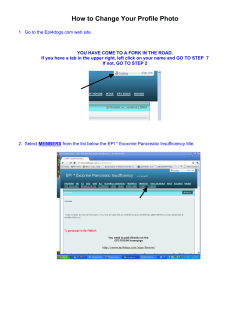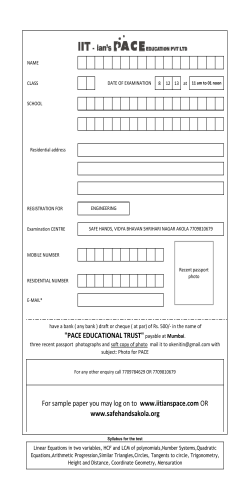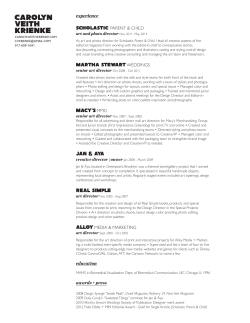
OPERATION & MAINTENANCE MANUAL DFI No. D00041
OPERATION & MAINTENANCE MANUAL DFI No. D00041 Facility Type: Detention Pond/Water Quality Biofiltration Swale Combo FEBRUARY 2011 INDEX 1. IDENTIFICATION......................................................................... 1 2. FACILITY CONTACT INFORMATION ........................................ 1 3. CONSTRUCTION ........................................................................ 2 4. STORM DRAIN SYSTEM AND FACILITY OVERVIEW .............. 2 5. FACILITY HAZ MAT SPILL FEATURE(S) ................................ 10 6. AUXILIARY OUTLET (HIGH FLOW BYPASS) ......................... 10 7. MAINTENANCE REQUIREMENTS ........................................... 11 8. WASTE MATERIAL HANDLING............................................... 12 APPENDIX A: Operational Plan and Profile Drawing(s) APPENDIX B: ODOT Project Plan Sheets 1. Identification Drainage Facility ID (DFI): D00041 Facility Type: Detention Pond/Water Quality Biofiltration Swale Combo Construction Drawings: (V-File Numbers) 42V-023, 38V-117 Location: District: 3 Highway No.: 001 Mile Post: 251.70 to 251.74 Description: This facility is located on the east side of the northbound travel lanes and onramp of I-5 (Hwy 001) just south of the SE Fairview Industrial Dr overpass, on the opposite side of SE Fairview Industrial Dr/ SE 32nd Ave from Litchfield Pl, and north of Kuebler Blvd. Access can be obtained from Fairview Industrial Dr/SE 32nd Ave. 2. Facility Contact Information Contact the Engineer of Record, Region Technical Center, or GeoEnvironmental’s Senior Hydraulics Engineer for: Operational clarification Maintenance clarification Repair or restoration assistance Engineering Contacts: Region Technical Center Hydro Unit Manager Or Geo-Environmental Senior Hydraulics Engineer (503) 986-3365. -1- 3. 4. Construction Engineer of Record: Region 2 Hydraulics, Chris Carman, (503) 986-2691 Facility construction: 2010 (Phase 2 42V-023), 2005 (Phase 1 38V-117) Contractor: K & E Excavating, Inc. (42V-023), Hamilton Construction Company (38V-117) Storm Drain System and Facility Overview A detention pond/water quality biofiltration swale combo (referred to from this point forward as a pond/swale combo) combines the forms and functions of a water quality swale and a detention pond. In a pond/swale combo, the biofiltration swale is situated within the bottom confines of the detention facility. The facility provides water quality treatment of the smaller storm events and detention of the larger storm events. The biofiltration swale is designed as if it were a separate facility and consists of a grassy-lined facility with a flat trapezoidal cross section and gradual slope. Treatment is provided through sedimentation and filtration processes. If amended soils are present, additional treatment is obtained through infiltration through the amended soil media. When the flows exceed the water quality flows, the pond/swale combo facility begins to provide detention. Detention is required to reduce or mitigate the increases in discharge, resulting from development. The facility is designed to store and gradually release (or attenuate) stormwater runoff via a control structure or release mechanism, then releasing it slowly over a more extended period of time. The flow control mechanism for this facility involves a 4-inch orifice surrounded by a wirecloth strainer assembly. When flows exceed the water quality design flow, the orifice restricts the flow causing the water to backup within the facility. This facility is located on the east side of the northbound travel lanes and onramp of I-5 (Hwy 001) just south of the SE Fairview Industrial Dr overpass, north of Kuebler Blvd. Photo 1 shows the facility with the I-5 (Hwy 001) overpass crossing SE Fairview Industrial Dr/SE 32nd Ave in the background. Access to the facility can be obtained from SE Fairview Industrial Drive/SE 32nd Avenue through an unlocked gate just south of the facility. Refer to the Operational Plan in Appendix A for the location of the gate and access point. The gate is northwest of the intersection between SE Fairview Industrial Dr/SE 32nd Ave and Litchfield Pl (Photo 2). After entry, a vehicular access path is just above the perimeter of the pond (Photo 3). -2- Stormwater runoff from paved areas along I-5 (Hwy 001) drains into this facility. Locations of these storm drain pipes are noted on the Operational Plan in Appendix A. Stormwater enters the facility through two inlets on the south side of the facility. One inlet, Inlet A, is a 24-inch diameter metal pipe, which receives stormwater from a nearby section of I-5 (Hwy 001) (Point A on the Operational Plan in Appendix A; Photo 4). The other inlet, Inlet B, is a 12inch diameter black HDPE pipe, which receives stormwater from the onramp connecting Kuebler Boulevard to I-5 (Hwy 001) (Point B on the Operational Plan in Appendix A; Photo 4). A flow spreader at the entry to the facility is formed of riprap. This flow spreader minimizes erosion and captures sediments from stormwater before its entry to the facility (Point C on the Operational Plan in Appendix A; Photo 4). Smaller storm events are treated by the grassy swale at the bottom of the facility. When the runoff exceeds the water quality flow, the facility serves as a detention pond where the release of water is controlled at the flow control manhole at the north end of the facility (Photo 1). After treatment and/or detention, the stormwater exits the pond/swale combo through a Type D ditch inlet structure at the north end of the facility. This structure has a grate, which captures larger debris and prevents it from entering the flow control manhole (Point D on the Operational Plan in Appendix A; Photos 1, 5). After passing through the grate, the stormwater enters the flow control manhole via an 18-inch diameter pipe. Inside the flow control manhole, the stormwater passes through a wirecloth strainer assembly at the bottom of the flow control structure, which further removes debris from the stormwater. This wirecloth strainer assembly must be kept unobstructed to ensure effective operation of the facility (Point E on the Operational Plan in Appendix A; Photos 6, 7, 8, 9). Then, the stormwater is discharged into a 24-inch diameter conveyance line, which transports the stormwater to a downstream storm sewer pipe underneath SE Fairview Industrial Drive/SE 32nd Avenue. North of the flow control manhole, there is an area drain, which discharges to the downstream conveyance line used by the facility. A manhole at the north of the facility’s property indicates the area drain’s connection to the conveyance line (Point F on the Operational Plan in Appendix A; Photo 10). The facility was built in two phases, Phase I and Phase II. Most of the facility built during Phase I: the pond/swale combo, Inlet A, the flow control manhole, the conveyance line, etc. (38V-117 in Appendix B.) In Phase II, Inlet B and -3- its related onramp inlets were added. Also, the diameter of the lower orifice in the flow control device in the flow control manhole was widened from 1 inch to 4 inches (42V-023 in Appendix B.) A. Maintenance equipment access: The facility can be accessed from SE Fairview Industrial Drive/SE 32nd Avenue. The facility is across from Litchfield Place where it intersects with SE Fairview Industrial Drive/SE 32nd Avenue. An unlocked gate northwest of this intersection is the entrance to the facility (Photo 2). After entry, a circuitous vehicular access path is just above the perimeter pond (Photo 3). B. Heavy equipment access into facility: Allowed (no limitations) Allowed (with limitations) Heavy equipment is allowed around the perimeter of the facility. Assess the condition of the pond prior to entering with heavy equipment. If wet, the pond may not support the weight of heavy equipment. Not allowed C. Special Features: Amended Soils Porous Pavers Liners Underdrains -4- Overpass Facility Outlet Flow Control Manhole Facility Inlet Photo 1: Facing northeast along facility. Metal inlet pipe at the bottom of photo. (Black plastic inlet pipe off to left not in photo.) Outlet beneath overpass (SE Fairview Industrial Drive and I-5 (Hwy 001)) at top of photo. Facility Access Gate SE Fairview Industrial Drive/SE 32nd Avenue Photo 2: This photo shows the access gate for the facility. -5- Photo 3: Vehicular maintenance access, which circles the pond/swale combo, is indicated by tire tracks. Inlet A, 24inch Diam. Inlet B, 12inch Diam. Photo 4: This photo shows the two facility inlets, Inlet A and Inlet B, at the south end of the facility. Flow spreader underneath formed of riprap. (Points A, B and C on the Operational Plan in Appendix A.) -6- Photo 5: Ditch inlet structure at north end of pond/swale combo (Point D on the Operational Plan in Appendix A.) Overpass Access N Access S Photo 6: Photo looking north at the flow control manhole (two access lids) in the foreground and the SE Fairview Industrial Drive overpass in the background. (Point E on the Operational Plan in Appendix A.) -7- Inlet to Manhole Inlet of Upper Orifice Overflow Riser Pipe Photo 7: Interior view from Access S to flow control manhole (Point E on Operational Plan in Appendix A) Overflow Riser Pipe Lower Orifice Draining Mechanism Outlet. 24inch Diam. Photo 8: Interior view from Access N to flow control manhole. Top of overflow riser pipe, lower orifice, outlet from manhole, draining mechanism (Point E on Operational Plan in Appendix A) -8- Upper Orifice Inlet. 18inch Diam. Overflow Riser Pipe Draining Mechanism Photo 9: Interior view from Access N to flow control manhole. Top of riser pipe, draining mechanism. Inlet illuminated by flashlight (Point E on Operational Plan in Appendix A) Manhole SE Fairview Industrial Drive/SE 32nd Avenue Area Drain Photo 10: Manhole at connection between facility conveyance line and pipe from area drain in the foreground (Point F on the Operational Plan in Appendix A). The facility conveyance line discharges into the stormwater system underneath SE Fairview Industrial Drive/SE 32nd Avenue. -9- 5. Facility Haz Mat Spill Feature(s) To store a volume of liquid in the pond and/or prevent hazardous material from leaving the facility, block the grate of the ditch inlet structure at the outlet of the pond/swale combo by placing a metal plate on top of the grate (Point D on the Operational Plan in Appendix A; Photo 5). 6. Auxiliary Outlet (High Flow Bypass) Auxiliary Outlets are provided if the primary outlet control structure cannot safely pass the projected high flows. Broad-crested spillway weirs and over flow risers are the two most common auxiliary outlets used in stormwater facility design. The auxiliary outlet feature is either a part of the facility or an additional storm drain feature/structure. The auxiliary outlet feature for this facility is: Designed into facility: This facility was designed to detain (in other words, store) increased stormwater runoff volumes, which resulted from increases of impervious area caused by roadway expansion. Detained water is slowly released from the pond through the lower orifice in the riser pipe in the flow control manhole (Photo 8). In the event that the lower orifice becomes plugged or the flows exceed the capacity of the facility, the water is released through the high flow riser found within the flow control manhole (Point E on the Operational Plan in Appendix A; Photos 7, 8, 9). The auxiliary high flow bypass for the flow control manhole consists of a 24-inch diameter pipe that rises above the outlet flow pipe in the flow control manhole. If stormwater enters the flow control manhole more quickly than the lower orifice can convey stormwater (due to either a larger storm or clogging of the lower orifice), the water level within the manhole will rise until water enters the riser pipe through its upper orifice. The water will then discharge through the 24-inch outlet pipe (Flow Control Structure Detail in the Operational Plan in Appendix A; working schematic on GJ-5 from 38V-117 in Appendix B; Photos 7, 8, 9). If the lower orifice clogs and the flow control manhole fills with water, use of the draining mechanism will quickly reduce the water level inside the manhole. The draining mechanism releases a removable watertight cap in the riser pipe, thus enabling flows to leave directly through the flow control manhole outlet and bypass the lower orifice, - 10 - the upper orifice and the top of the riser pipe (Operational Plan in Appendix A; Photos 8, 9). Other, as noted below 7. Maintenance Requirements Routine maintenance tables for non-proprietary stormwater treatment and storage/detention facilities have been incorporated into ODOT’s Maintenance Guide. These tables summarize the maintenance requirements for ponds, swales, filter strips, bioslopes, and detention tanks and vaults. Special maintenance requirements in addition to the routine requirements are noted below when applicable. The ODOT Maintenance Guide can be viewed at the following website: http://www.oregon.gov/ODOT/HWY/OOM/MGuide.shtml Maintenance requirements for proprietary structures, such as underground water quality manholes and/or vaults with filter media are noted in Appendix C when applicable. The following stormwater facility maintenance table (See ODOT Maintenance Guide) should be used to maintain the facility outlined in this Operation and Maintenance Manual or follow the Maintenance requirements outlined in Appendix C when proprietary structure is selected below: Table 1 (general maintenance) Table 2 (stormwater ponds) Table 3 (water quality biofiltration swales) Table 4 (water quality filter strips) Table 5 (water quality bioslopes) Table 6 (detention tank) Table 7 (detention vault) Appendix C (proprietary structure) Special Maintenance requirements: None. - 11 - 8. Waste Material Handling Material removed from the facility is defined as waste by DEQ. Refer to the roadwaste section of the ODOT Maintenance Yard Environmental Management System (EMS) Policy and Procedures Manual for disposal options: http://egov.oregon.gov/ODOT/HWY/OOM/EMS.shtml Contact any of the following for more detailed information about management of waste materials found on site: ODOT Clean Water Unit ODOT Statewide Hazmat Coordinator ODOT Region Hazmat Coordinator ODEQ Northwest Region Office (503) 986-3008 (503) 229-5129 (503) 986-2647 (503) 229-5263 - 12 - Appendix A Content: Operational Plan and Profile Drawing(s) - 13 - Litchfield Pl. M ar Note: Manhole is 6 Ft. in Dia. and 8.5 Ft. Deep. 32nd Ave. S.E. ie tt a Access Gate S t. Draining mechanism Facility access from Kuebler Blvd off I-5 Manhole lid 2 S .E . Existing ground A Mile Point 251.74 " 24 12" Detention Pond/WQ Biofiltration Swale Combo (DFI D00041) | 268 ft. 24" F 18" Location of top of riser. High flows exit through riser opening. Mile Point 251.70 6 Upper orifice 24" 10 D E Outlet flow C A 12 " 5 12" 12" Location of lower orifice. Detention flows exit through the lower orifice. B 4 12" 1 Ba 18" A 24" rri er 12" Wirecloth strainer assembly prevents lower orifice from plugging. 12" Flow Control Structure for Detention Pond/Water Quality Biofiltration Swale Combo (DFI D00041) 3 I-5 On Ramp From Kuebler Boulevard 24" M 12" ed ian No rth cif bo ic un Hi d g (In hwa Lane 12" y ter s sta , Hw y0 te 5) 01 ) (Pa 15" LEGEND: So cif uthb ic ou Hi nd g (In hwa Lan e y ter sta , Hw s te y0 5) 01 (Pa PLAN Photo Location / Direction Dit ch 12" ) A Inlet A B Inlet B C Flow Spreader D Type ’D’ Ditch Inlet Structure E Flow Control Manhole F Manhole Connecting Area N.T.S. Drain To Conveyance Line 12" Access Gate Detention Pond/WQ Biofiltration Swale Combo (DFI D00041) 8, 9 F Manhole and or Inlet Storm Pipe (Facility) Storm Pipe | 268 ft. 7 Ground Maximum water depth E Conveyance Direction Manhole Pavement / Facility Flow Path Ground 12" and or 12" D 24" Outlet pipe from pond A B Pond/swale bottom 24" 18" OREGON DEPARTMENT OF TRANSPORTATION C Pond/swale storage volume Prepared By: Wynee Hu SECTION A-A N.T.S. Drafted By: Jim Holeman DFI D00041 MAINTENANCE DISTRICT 3 HWY 001 DETENTION POND/WQ BIOFILTRATION SWALE PACIFIC HIGHWAY MP 251.70-251.74 MARION COUNTY G:\HYDRAULICS\OM\WORKING\03_001_D00041\Operational Plan\DFI_D00041.dgn :: Default 5/10/2011 3:02:14 PM hwye94w DFI_D00041.dgn Ditch Appendix B Content: ODOT Project Plan Sheets - 14 - Revised Plan Sheets Incorporated Revised Plan Sheets Incorporated
© Copyright 2025










